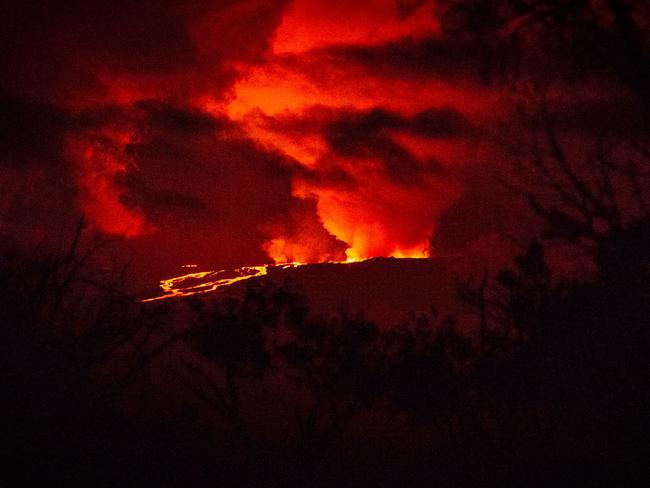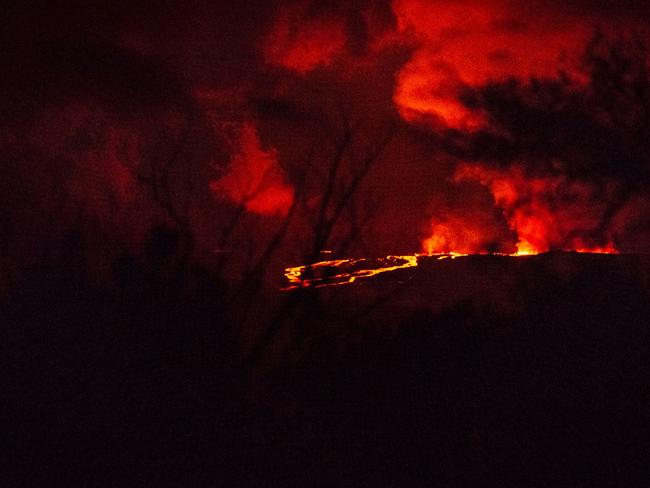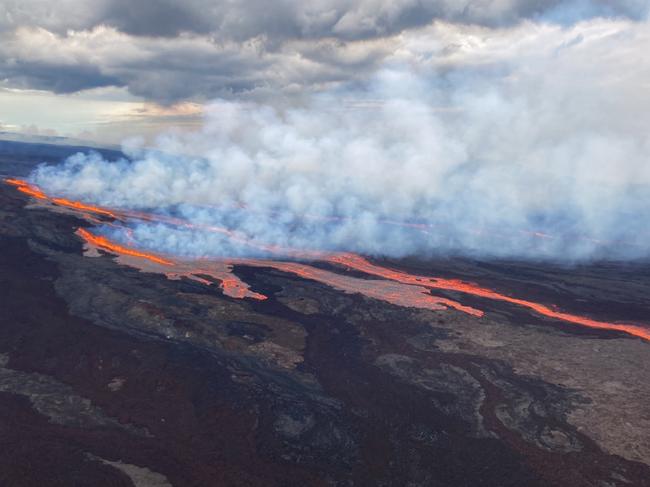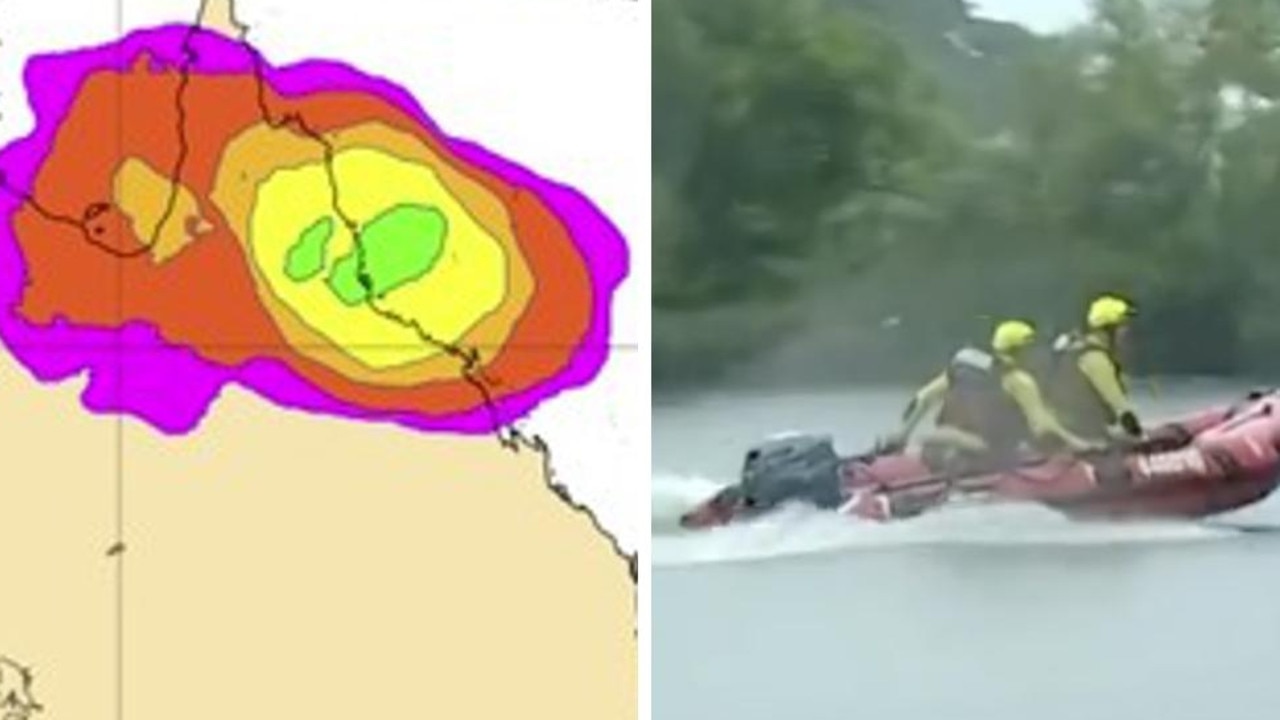Hawaii’s Mauna Loa volcano erupts for first time in almost 40 years
The world’s largest volcano has put on a spectacular display of nature’s fury spewing lava and hot ash. See photos, video.
Environment
Don't miss out on the headlines from Environment. Followed categories will be added to My News.
The world’s largest active volcano, Hawaii’s Mauna Loa, is sending ash and volcanic debris into the sky and prompting residents to review their evacuation preparations.
Mauna Loa, located on the Big Island of Hawaii, erupted for the first time in 40 years late on Sunday night, local time.
Although lava is flowing down one side of the volcano, the eruption in Hawaii Volcanoes National Park is not threatening communities, according to the US Geological Survey.

“All indications are that the eruption will remain in the Northeast Rift Zone,” the agency said in an advisory, referring to an area where a volcano is splitting, allowing for lava flow. “Volcanic gas and possibly fine ash and Pele’s Hair (strands of lava glass) may be carried downwind.”
However, the agency has warned local residents to be prepared.
The volcano last erupted in 1984 but scientists have been monitoring an increasing number of earthquakes at the summit.

Satellites operated by the National Oceanographic and Atmospheric Administration (NOAA) captured the extraordinary eruption, with one animated image recording its thermal signature and a large plume of gas spreading to the northeast of Hawaii on Sunday.
“Around 11:30pm. HST last night, @NOAA’s #GOESWest captured the eruption of Hawaii’s #MaunaLoa volcano, inside @Volcanoes_NPS,” NOAA tweeted.
“This imagery shows the heat signature and the sulfur dioxide released from the #volcano’s summit caldera, Moku‘āweoweo.”

The Mauna Loa volcano in Hawaiʻi's Volcanoes National Park on the Big Island erupted overnight. #GOESWest is tracking the thermal signature of the explosive event, as well as the ash and debris cloud. Updates at https://t.co/Pm6hBJrYvg@USGSVolcanoes#MaunaLoaVolcanopic.twitter.com/CQZ1rOvKo1
— UW-Madison CIMSS (@UWCIMSS) November 28, 2022
Mauna Loa rises 4169 metres above sea level and is a much larger volcano than the Kilauea volcano, also on the Big Island, which erupted in 2018 and wiped out 700 homes on Hawaii.
Local authorities are concerned that when Mauna Loa fully erupts the lava flow will be much faster due to the steeper inclines of the volcano.
This is the first time Mauna Loa has erupted in 38 years.
Local authorities have upgraded the advisory from ‘alert’ to ‘RED/WARNING.’
To recap, 3 fissures erupted but as of 1:30 PM, only the lowest of the three fissures was active. Estimates of the tallest fountain heights are between 100–200 ft (30–60 m), but most are a few yards (meters) tall. pic.twitter.com/hdchghwB1N
— USGS Volcanoes🌋 (@USGSVolcanoes) November 29, 2022
The advisory warns: “Winds may carry volcanic gas and possibly fine ash” downwind.
“Residents at risk from Mauna Loa lava flows should review preparedness and refer to Hawaii County Civil Defense information for further guidance.
Based on past events, the early stages of a Mauna Loa eruption can be very dynamic and the location and advance of lava flows can change rapidly.

If the eruption remains in Moku‘āweoweo, lava flows will most likely be confined within the caldera walls. However, if the eruptive vents migrate outside its walls, lava flows may move rapidly downslope.”
The agency said it will be “monitoring the volcano closely to provide further updates on activity. As soon as possible, HVO will conduct aerial reconnaissance to better describe the eruption and assess hazards.”
Mauna Loa has been showing signs of building to an eruption for years, according to the USGS, which said the ongoing eruption was visible from Kona, a town on the west coast of Hawaii’s main island some 72 kilometres from the volcano.
Mauna Loa eruption hawaii right now pic.twitter.com/uQz5OXwTg2
— kelly (@MAGAHAWAII) November 28, 2022
“Lava is still erupting from the summit & is overflowing from the caldera,” the USGS said on its website, referring to the basin at the top of a volcano. While it added there were “no threats to populated areas currently,” it urged area residents to review preparedness procedures.
“If the eruptive vents migrate outside its walls, lava flows may move rapidly downslope,” according to the USGS.
An ashfall advisory has been issued for downwind of the volcano, with a light accumulation of ash expected on ships in ocean waters along the Big Island’s southeast.

A USGS webcam on Mauna Loa summit’s north rim showed long bright eruptive fissures within the volcanic crater, contrasted against the dark of night.
Robin George Andrews, a scientist and volcanologist, said a larger threat exists if magma begins to pour out of so-called rift zones along the volcano’s flanks.
While there is no evidence yet of this occurring now on Mauna Loa, “the fact that it is a hazardous mountain that hasn’t erupted since 1984 — the longest eruptive pause in its recorded history — is why we should all keep an eye on it,” Andrews posted on Twitter.

HVO Mauna Loa RED/WARNING - Mauna Loa summit eruption continues. https://t.co/fT0UDf2hkJ
— USGS Volcanoes🌋 (@USGSVolcanoes) November 28, 2022
The largest volcano on Earth by volume, Mauna Loa, whose name means “Long Mountain,” covers half of the Big Island and is larger than the rest of the Hawaiian Islands combined.
One of six active volcanoes on the Hawaiian Islands, Mauna Loa has erupted 33 times since 1843, according to USGS.
The most recent eruption, in 1984, lasted 22 days and produced lava flows which reached to within about seven kilometres (four miles) of Hilo, a city to the northeast which is home to about 44,000 people today.
Kilauea, a volcano on the southeastern flank of Mauna Loa, erupted almost continuously between 1983 and 2019, and a current minor eruption there has been ongoing for months.
— with AFP




